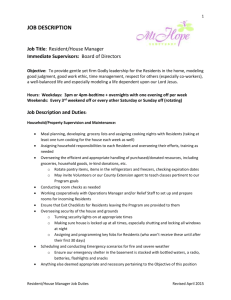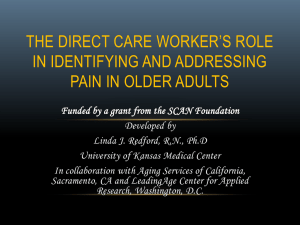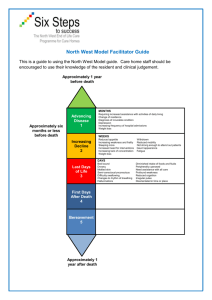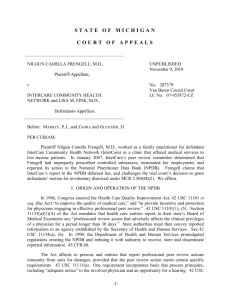Health and Safety for Volunteers
advertisement
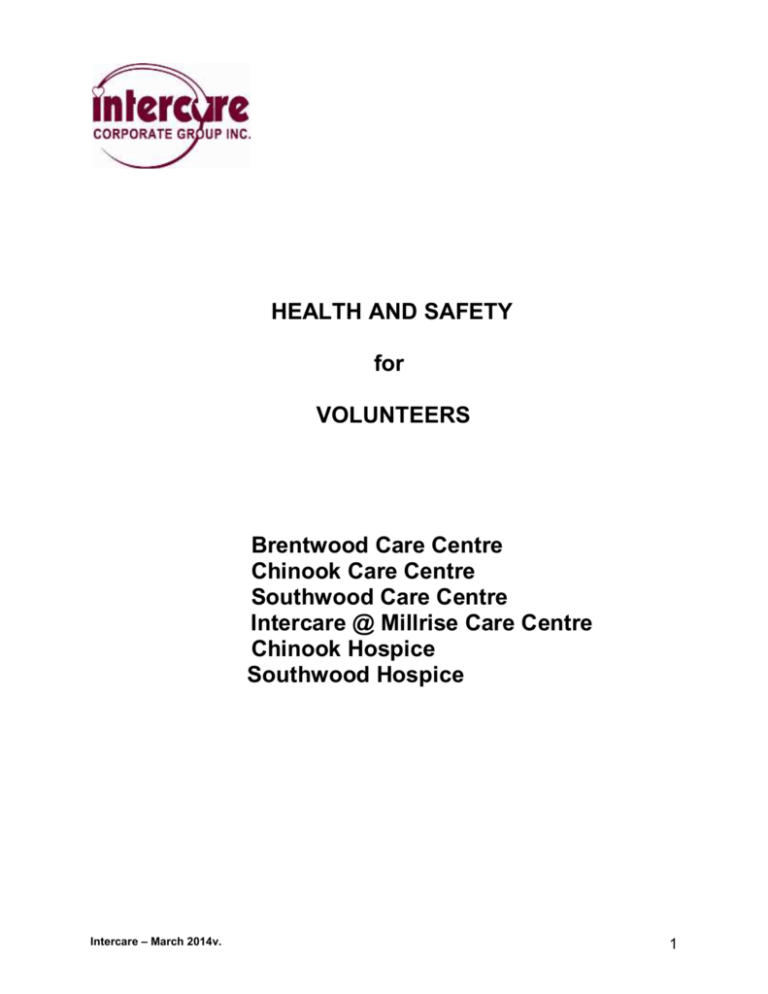
HEALTH AND SAFETY for VOLUNTEERS Brentwood Care Centre Chinook Care Centre Southwood Care Centre Intercare @ Millrise Care Centre Chinook Hospice Southwood Hospice Intercare – March 2014v. 1 Health and Safety for Volunteers Intercare’s Health, Safety and Wellness Policy (HR Policy # 06-00-00) It is everyone’s responsibility and accountability to contribute to the health and safety within Intercare’s work environment. This includes a commitment to the safety and well being of our residents and others around us, including ourselves. Active participation by everyone is necessary for the achievement of safety excellence and due diligence that Intercare expects within its care centres. The Health, Safety and Wellness policy outlines specific responsibilities for employees, supervisors, management, visitors, volunteers and contracted Service Providers. Volunteer responsibilities are: o To maintain and promote a safe and healthy work environment o To know and comply with safe work procedures and practices o To use protective equipment as required o To report near misses, injuries, unsafe acts or conditions and broken equipment immediately to a facility supervisor o To work with facility supervisors and management towards continuous improvement in health and safety conditions at work o To correct unsafe acts or practices as able The related policy is located in the Human Resources (HR) policy manual and is also posted on the Health and Safety board located by staff rooms. What should you do if you are hurt at work? Report to the First Aid Station: o Brentwood Care Centre – St. Andrews nursing station o Chinook Care Centre – Richard’s Way nursing station o Southwood Care Centre Parkland nursing station o Intercare @ Millrise – 3rd Floor nursing station o Chinook Hospice – Nursing station o Southwood Hospice – Nursing station Complete an Employee Incident and Investigation form and submit to the Facility Leader. WCB packages and Needle Stick Kits can be found at each Care Centre’s respective First Aid Stations. All incidents are investigated to determine root causes and prevent re-occurrence Near misses must also be reported (a near miss is an incident where you or another person (s) could have been harmed) What should you do if you observe an unsafe work condition? Fix it yourself, if you safely can (e.g. cleaning up a spill on the floor) If you cannot fix it yourself , make a staff member aware and have the staff member note the problem in the Maintenance Book Fill out and submit an Intercare Feedback Form (available on all nursing units) If there is imminent danger, ensure that you immediately report it to a staff member Intercare – March 2014v. 2 Health and Safety for Volunteers Emergency Response There are various types of emergencies that may arise within our care centres (fire, flood, missing resident, etc). Intercare’s first priority in the face of an emergency is the safety and well being of its residents, staff and visitors in the building. Though challenging, one of the most important things to remember in such a situation is to remain calm. Particular actions taken by staff will depend upon the type of emergency. Intercare follows the National Code System as follows: Code Red Code Green Code Yellow Code Blue Code Black Code White Code Orange – Fire – Evacuation (same process no matter what the reason for evacuation) – Missing Resident – Medical Emergency – Bomb Threat – Security Plan (Aggressive Behavior and Suspicious Person) – Disaster Plan In the event of an emergency (Code Red), stay calm and: Follow the directions of facility staff If you are with residents, stay with the residents in a safe location and follow directions of staff or person in charge If you are not with residents, go to the front lobby or nearest nursing station, whichever is closer and wait for further instructions Do not run or shout “FIRE” Turn off all equipment Do not use the elevator Do not cross into the Fire Zone If there is a Fire Alarm, listen for the “Code Red” page and the fire location which will be paged through the desk sets and handheld phones. After alarms have stopped sounding, do not resume normal duties until “Code Red All Clear” has been announced, which will be paged through the desk sets and handheld phones. If you discover a fire in your area, implement ‘REACT’: R – Remove residents in danger (room where fire is, rooms on either side and rooms across the hall E – Ensure that room door is closed A – Activate fire alarm (if not already sounding) C – Call the fire department T – Try to extinguish fire (only if it is a small fire and you are confident you can put it out) Intercare – March 2014v. 3 Health and Safety for Volunteers Code Green – Evacuation The same method for evacuation is used regardless of the cause (fire, flood, gas leak etc.). If there is a need to evacuate, “Code Green” (including location) will be paged through the desk sets and handheld phones. 1. Staff nurses in affected areas will direct the evacuation 2. The ‘Team and Chain System’ will be used: a) Staff line up singly or in pairs from the area of danger out to an area of safety b) First staff/pair go into the room and check room, evacuate resident, place red tag on door and walk resident down to next pair of staff (i.e. resident is removed to an area of safety) c) Second pair of staff receive resident and walk them down to next pair d) First pair go to next room e) Process continues until all residents in affected area are moved to safety 3. Priority order of evacuation: a) Residents in immediate danger b) Residents/ visitors who can walk on their own c) Residents who can move on their own but need some assistance d) Residents unable to move on their own 4. “Code Green – All Clear” will be paged three (3) times through the desk sets and handheld phones. Volunteer Responsibilities: Report to the nearest nursing station – follow directions of the staff nurse. Code Yellow – Missing Resident Some residents in continuing care may be in danger of ‘eloping’ from the building. Good communication and quick action are essential if a resident is missing. If a resident is missing, “Code Yellow (resident name, home unit)” will be paged three (3) times through the desk sets and handheld phones. 1. All staff will immediately begin searching all areas of the building 2. Two (2) staff will search grounds and two staff will search a four (4) block radius by car 3. Police non- emergency will be notified, as well as family/responsible person 4. “Code Yellow – All Clear” will be paged three (3) times once the resident is found Volunteer Responsibilities: Check your work area and report to staff immediately if you discover the resident. Intercare – March 2014v. 4 Health and Safety for Volunteers Code Blue – Medical Emergency A medical emergency could involve a resident, family member, visitor or staff member. A “Code Blue” summons a Staff Nurse who will perform First Aid. The closest available person will call 9-1-1 while the Staff Nurse continues First Aid until paramedics arrive. “Code Blue - All Clear” will be paged three (3) times through the desk sets and handheld phones once the emergency is over. Volunteer Responsibilities: If you discover a medical emergency, call for help and ask staff to page “Code Blue (including location)” three (3) times. Code Black – Bomb Threat Any threat must be taken seriously. In the event of a bomb threat, “Code Black” will be paged through the desk sets and handheld phones three (3) times. The staff person in charge will call 9-1-1 and a search will be conducted with police. “Code Black - All Clear” will be paged three (3) times through the desk sets and handheld phones once the emergency is over. Volunteer Responsibilities: Remain where you are and wait for directions from the staff person in charge. Do not touch any suspicious packages, items etc. Code White – Security Code White means that someone is in imminent danger of injury from a suspicious or aggressive person in the building. “Code White (location)” will be paged three (3) times overhead and all available staff will to report to this location to assist. If the staff nurse in the area cannot bring the situation under control, he/she will call 9-1-1. “Code White - All Clear” will be paged three (3) times through the desk sets and handheld phones once the emergency is over. Volunteer Responsibilities: If you are being threatened or feel threatened, seek assistance from staff. If you hear the “Code White” page, remain in your work area and wait for further direction. Intercare – March 2014v. 5 Health and Safety for Volunteers Code Orange – External Disaster A Code Orange signifies a disaster happening outside an Intercare facility which may pose significant risk to safety – for example: tornado, flood, explosion etc. “Code Orange – Return to your workstation” will be paged through the desk sets and handheld phones three (3) times. Volunteer Responsibilities: Report to the nearest nursing station for directions. Intercare also has “Contingency Plans” in place to ensure the continuation of necessary facility services to residents in the event of service disruptions such as: loss of power; loss of water; disruption to housekeeping and laundry services; disruption to safety and security services; and disruption to meal services. The Contingency Plans are included in Intercare’s Emergency Response Manual. Workplace Hazardous Materials Information System (WHMIS) Intercare adheres to all federal and provincial WHMIS legislation. Volunteer Responsibilities: 1. Ensure that appropriate safe handling procedures are used when working with controlled products. 2. Report any concerns to staff immediately. Infection Prevention and Control (IPC) Residents in continuing care are at higher risk of infection due to a variety of physical conditions. It is everyone’s responsibility to prevent and reduce the spread of infection by using Universal (Standard) Precautions. Volunteer Responsibilities: 1. Comply with all applicable professional standards of practice and required provincial and Intercare policies. 2. Handwashing – wash your hands anytime they are visibly soiled and if you have touched any potentially contaminated surfaces/substances. Use the alcohol based hand cleansers frequently while on site in addition to regular handwashing. 3. Gloves – use gloves if your work involves any contact with body fluids. 4. Aseptic technique – Do not move germs from areas that are potentially “dirty” to areas that are clean. 5. In the case of an outbreak (numerous cases of a particular illness), Volunteers will not be allowed in the building unless absolutely necessary. Signage advising of an outbreak will be posted at the entry. You are encouraged to call the facility for updates to determine when you will be allowed to return. Intercare – March 2014v. 6



